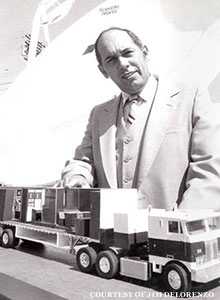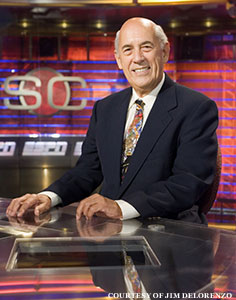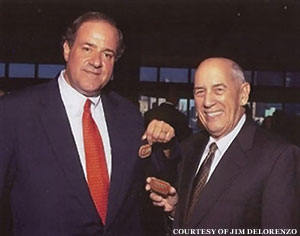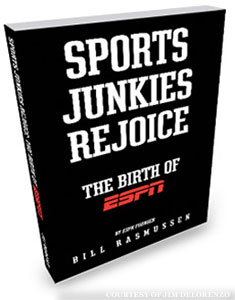
Johnny Carson, Robin Williams, Ted Turner, Tom Snyder and Bill Rasmussen: What do they all have in common?
You may be asking yourself, "Who's Bill Rasmussen?"
Though not exactly a household name, Mr. Rasmussen is one of the founders of ESPN, which is most definitely a household name. In fact, it was from his imagination that the seed blossomed.
In answer to our little trivia question above, all of them were included in a 1979 "Newsweek" article titled, "Twelve of the Biggest Headline Makers of the Year."
With the release of the widely anticipated "Those Guys Have All the Fun: Inside the World of ESPN," by James Andrew Miller and Tom Shales, it was the perfect time for Bill to rerelease his first-person account of how we, as a society, came upon televised sports at all hours of the day and night.
I met Bill at the recent Book Expo America in New York City as he was promoting "Sports Junkies Rejoice: The Birth of ESPN." Originally published in 1983, this edition of his tale is published through CreateSpace, part of the Amazon group of companies that includes Kindle, itself an advance in distribution. It's an up-and-coming company, just as Bill likes 'em.
"Sports Junkies Rejoice" takes you from conception to execution of the bold new idea for a 24-hour cable sports network. It brings you back to a time when the landscape we take for granted today was virtually inconceivable. Four years earlier saw the introduction of the original "not-ready-for-prime-time players" and then in the late summer of '79, along came the "not-ready-for-24-hours-a-day players." Similar to "Saturday Night Live," it has become a staple of our culture, with many attempting to emulate it.
As his background was in sports broadcasting, a conversation with Bill is like listening to a game. He still speaks with an enthusiasm for the subject, as if he's making his pitch for his E.S.P. Network, the concept's original name, all over again.
The story itself has all the elements of a gripping nail-biter of a championship series -– twists and turns, great saves, heroes, characters and egos. It resembles something ESPN might in fact cover today.

What began as an idea for a few hours a night of regional coverage, revolving mainly around 25 to 30 UConn events per year, turned into a seismic shift in the way we view sports ... with a little help from his friends and some family.
The expansion of hours came about simply because his son Scott sought out the bargain. For you see, the cost for five hours of transponder access was $1,250 per day, compared to only $1,143 per day for 24 hours. So it was a no-brainer. They just needed to figure out what to program for the entire 24 hours.
(For those unfamiliar with and uninterested in the science of television, that was our last mention of the word "transponder," except for this randomly out of place usage here -– transponder.)
It wasn't until a traffic jam on their way to the Jersey Shore in August when Scott said, in a moment of tension, "Play football all day, for all I care."
So there it was. Of course, they needed to get the programming ... and the financing ... and the cable providers. Their quote to the cable systems they wooed was the ridiculously exorbitant $.01 per day per subscriber -– a cost of $.30 per month -– triple that of Ted Turner's already established SuperStation WTBS. (Ah, yes, the days when you could either watch your home team’s UHF broadcast or the Atlanta Braves.) They were essentially laughed out of meetings.
So they reassessed their plan, deciding instead to make it wholly ad-based, unheard of for a cable network at the time. Now they needed to get the programming, the financing, the cable providers, and the sponsors. That was along with remote television vans and a home studio.
Overall, there were more than a few naysayers, including Ron Burgandy. A popular YouTube clip shows the fictitious star of "Anchorman," which was set in the late 70s, auditioning at the fledgling network. After pronouncing it Ehspehn, he proceeded to go on a rant saying that sports all the time was "never gonna work ... I mean, that's like a 24-hour cooking network, or an all-music channel ... Seriously, this thing is going to be a financial and cultural disaster."
Bill laughs at the mention of the comedy short, but claims it wasn't too far off from some of the feedback he received, though it also inadvertently shows the hand this little network may have had in influencing other staples of TV that now cover every niche you can think of. (Well, except an all hair-grooming channel, but that's probably just a matter of time.)

Just 14 months after the original meeting with a couple of guys in a tiny office in tiny Plainville, Connecticut, the studio in Bristol was almost fully operational (at least it was close enough to begin a network). So with the former head of NBC Sports Chet Simmons now in charge, they had done it.
The story is amazing, but not altogether unheard of. It's the quintessential 10 percent inspiration and 90 percent perspiration (with a lot of luck thrown in) tale. The whole thing was a true team effort.
Then, like many championship teams in this day and age, it was disbanded shortly after their triumphant launch, with the influx of an experienced team from NBC Sports, recommended by Simmons.
"Sports Junkies Rejoice" focuses wholly on the chronology of events that brought about the new network whereas Shales and Miller treat the early days as the backstory to get to the meat of their book, a behind-the-scenes snapshot of the sports network we've come to know and love.
Bill, for his role in enhancing our abilities to view sports, has gone on to other endeavors, including an accomplished public speaking career.
He may not have spent much time at ESPN overall, but he's not complaining as he's had enough perks in his life to make any sports fan green with envy. The former Detroit Tigers farm club invitee enjoyed the local Bristol softball leagues along with charity games during his association with ESPN.
"I was playing third base for a charity game," Bill begins. "Coaching third was Joe DiMaggio and up at bat was then-New York Met Willie Mays. And DiMaggio is riding the ump. I said, 'Joe. Easy, it's a charity game.'"

Bill currently lives in Seattle with his wife, apparently as a horticulturist. "There are three flowers growing there," he tells me, referring to his granddaughters.
He still has an exuberance and curiosity toward what the future has to offer us. "High school games will be broadcast," he says. "In fact, there will be an angle on each individual player. You'll be able to choose who you want to focus on."
He gives the impression that he wonders how we're come to this point.
I've got an idea, Bill. I think you started it.
Nowadays, we can get our sports anywhere we want it –- on our televisions, our computers, our mobile devices. Tomorrow, we could have a hologram of Roy Halladay pitching to us in our living rooms. Who knows?
And though Bill does not have a new innovation up his sleeve, he should not be so surprised as to how one concept might build upon another. For, if anyone knows the magic in a seed, it's Bill. What began as a simple idea to broadcast a few regional games turned into a brand new world.
Yes, it took some serendipitous merging of inspiration and circumstance, but there was probably a lot of that in the stories of Carson, Williams, Turner and Snyder. And that's another thing that Bill Rasmussen has in common with them.




